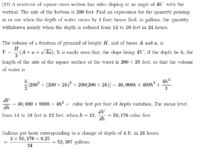Air conditionner
New member
- Joined
- Jun 29, 2021
- Messages
- 24
Hi!
It's been a few hours I'm blocking on a math problem. I've tried asking parents, tutors on Gauthmath, but I'm still blocked.
The problem is written in a calculus book. The answer, and the solving steps are there, but there's a little thing I can't seem to understand.
Could you please help me?
 It took me a good 30 mins with my mom to find out the reservoir was inverted. I didn't know they existed. And then I had to convert the unitsXD. Anyway, I managed to find the derivative.
It took me a good 30 mins with my mom to find out the reservoir was inverted. I didn't know they existed. And then I had to convert the unitsXD. Anyway, I managed to find the derivative.
My problem is: I don't understand why they take the mean level, from 14 to 10 feet. Why couldn't they just use the formula for the volume at 14 feet, and then substract the volume at 10 feet? And finally, divide by 24 hours?
Maybe there's 2 ways of doing it. Anyway, I would really like to understand the ``calculus`` way (which is why I'm reading the book).
I think I'm just stuck on what the mean level represents. And the dV over dh...
Thank you in advance,
Air conditionner
It's been a few hours I'm blocking on a math problem. I've tried asking parents, tutors on Gauthmath, but I'm still blocked.
The problem is written in a calculus book. The answer, and the solving steps are there, but there's a little thing I can't seem to understand.
Could you please help me?
 It took me a good 30 mins with my mom to find out the reservoir was inverted. I didn't know they existed. And then I had to convert the unitsXD. Anyway, I managed to find the derivative.
It took me a good 30 mins with my mom to find out the reservoir was inverted. I didn't know they existed. And then I had to convert the unitsXD. Anyway, I managed to find the derivative.My problem is: I don't understand why they take the mean level, from 14 to 10 feet. Why couldn't they just use the formula for the volume at 14 feet, and then substract the volume at 10 feet? And finally, divide by 24 hours?
Maybe there's 2 ways of doing it. Anyway, I would really like to understand the ``calculus`` way (which is why I'm reading the book).
I think I'm just stuck on what the mean level represents. And the dV over dh...
Thank you in advance,
Air conditionner

